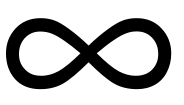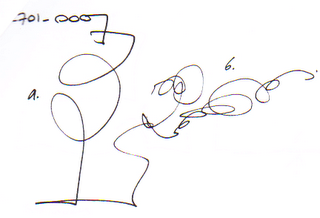The Ideogram is a cornerstone of the CRV (Controlled Remote Viewing) methodology created by Ingo Swann (Circa 1979-1988) as a consultant for SRI. The Ideogram has also been adopted by the following mutated forms of CRV but at times it’s been given less of a prominence in these later methodologies.
Firstly what is an Ideogram?
Simply put - An ideogram is a pictorial representation of an idea or concept.

For example:
This drawn symbol or shape is now commonly known to represent infinity. It cant possibly show everything that a concept like infinity means - but its shape and form represents the concept of infinity.
In CRV, the Ideogram represents an instantaneous reflex capture of the remote viewing target in picture form. A pictorial summary of the target.
The Ideogram takes the form of a reflex action with no drive form the conscious mind as it skips across the pages at a lightening pace. The Ideogram is then lightly probed to extract its ‘feeling’ its ‘form’ and its sensory impressions.
In essence in the many years of doing ideograms they have become known to me as an object of beauty, an art form, an expression of the entire target and every single bit of data, captured within a sweep on the pen.
Each and every single ideogram is different and although some have common features like straight or intersecting lines representing structures, most ideograms have that like bit extra, a subtlety that radiates the needed information. The key is to take the time to respect, explore and decode the ideogram properly. I’ve seen student want to skip this target of the remote viewing process in their willingness to sketch or delve into the depths of a target, yet it’s all here wrapped up in a beautiful, purely creative and personal expression of the target.
Over the years I have come to see ideograms as single works of art - a pure unaltered expression of the remote target, untouched by noise as it momentarily explodes form the creative mind on to the paper and dissipates in a nano-second. I can look back on a remote viewing session containing multiple layered ideograms and with the hindsight of feedback - I see mapped in the swirling lines and unconsciously created ‘art’ a map of the target laid bare, waiting to be probed and discovered. Lying within the ideogram is a creative language stronger and more intense than any language of words.
A Recent example:

This is an ideogram recently created in a remote viewing project for a missing person.
At the point where the random target number ended you can see the creative explosion of information travel through me, into the pen and then on to the paper. You can trace the flow of the pen in the great arcing swirls and downwards as it records a life form, labelled [a.].
Then it skips across the page wanting to impart more information, which it does in a secondary explosion of sweeps and swirls reaching across the white void. This second Ideogram is labelled [b.] and when probed it indicates the confused, heavy, stifling, busy, mental condition of the target life form. This is a nano-second of creative expression, detailing a complex mental condition involving depression and sever confusion. On probing I can sense this, see it and feels it, a cloudy puffiness that takes over all.
The creative side of me sees this Ideogram as a thing of beauty a swirling form of energy as if reaching out across the pages with a story to tell.
It turns out the Missing person is a male with a severe mental condition who is prone to episodes of confusion, and who is still missing, presumed dead.
For the practitioners out there - remember to take your time and have fun with the Ideogram part of the process, it’s the creative side of you expressing the target in ‘your’ personal language. It also shows that behind all the acronyms and words that remote viewing IS an artistic process and that your Ideograms, sketches and even your pages of information are like little galleries filed with works of art., your art, learn to love and respect them.
For those methodologies or practitioners that have bypassed or relegated the Ideogram to a secondary position in your process - you need to re-evaluate this, go back and give it another try, look deep into the action and expression that explodes form both the target and from within in each of these little artworks.
All the best...
Daz
No comments:
Post a Comment
Note: Only a member of this blog may post a comment.